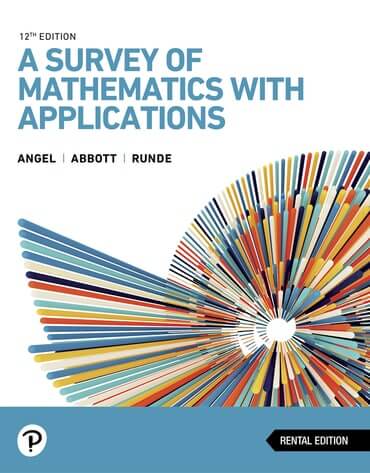Join instructor Cathy Evins to hear how flipping her class made her class time more effective and improved course outcomes.
Liberal Arts Math & Quantitative Reasoning
Support your students’ learning with these resources
Making quantitative reasoning easier to teach
Learn about improvements made in the 3rd edition of Eric Gaze’s Thinking Quantitatively, making it more user-friendly.
Dynamic teaching and learning tools
Each MyLab course includes media like GeoGebra animations, StatCrunch, and videos that deepen understanding of concepts.
Real-time, active student engagement
Gauge student understanding in real-time with title-specific liberal arts math questions in Learning Catalytics.




Explore titles for liberal arts math and quantitative reasoning.
Join Aaron Warnock, Faculty Advisor at Pearson, to learn why Learning Catalytics can become an effective student engagement tool in your MyLab® courses.
Join Dr. Jeffrey Bennett for a strategy discussion, featuring examples for improving our teaching success at almost any level of math and statistics.
-
Tips to Help Instructors Feel Inspired at the Start of a New School Year
They’re BAAAAAAAAACK!
We survived teaching through the COVID-19 pandemic, teaching in the early days post-pandemic, and this year we thought we would be returning to some new normal in our classrooms.
But wait, there are new (and not so new) mine fields I’m expected to navigate?!
- ChatGPT??
- Political climates influencing what and how we teach??
- Continuing updates to accessibility??
- Commitments to inclusive teaching??
I feel a weariness creeping in as I struggle to stay enthusiastic about this new school year. So, I sought solace from like-minded educators and sources to help renew my excitement and confidence about stepping into the limelight with a whole new, unknown group of students.
I found this quote from a fellow teacher.
-
Emphasizing development of the Affective Domain and “Soft Skills” in Collegiate Math
The Role of the Affective Domain and ‘Soft Skills’ in Collegiate Math
Although students are reaching college-level math classes sooner due to many of the recent acceleration projects, they often arrive without developing many of the student skills that would improve their chances for success. One way we can help our students to develop those skills is through the use of prompts and assignments that focus on the affective domain.
I like to use a series of prompts in my classes, because they are powerful and flexible. They can be used for writing assignments, discussion board prompts, or to start face-to-face classroom discussions. The in-person discussions can start with student volunteers sharing their responses, or they could use a think-pair-share format. They fit well in corequisite support classes, as well as the main credit bearing course. Finally, the instructor could devote as little as 5-10 minutes of class time to these prompts or use an entire class session.
I focus on topics that I feel are most beneficial to my students, helping them to be more successful in my class as well as becoming a better learner in general. I like to start with prompts related to developing a growth mindset, because I believe that helping students reset their mindset regarding mathematics is an important first step on the path to success.
I then follow up with prompts related to time management. Our students are over committed, yet lack skills for scheduling, organizing, or prioritizing tasks. Many students struggle with procrastination as well. These prompts lead to discussion and the discovery of strategies to improve time management.
After growth mindset and time management, I like to add prompts for goal setting using S.M.A.R.T. goals, reflection, and other study skills. You can tailor your choice of subjects to the skills you feel are most important, or to build up skills that your students need the most help with.
Lastly, I have assembled a set of 30 prompts that are included in the new third edition of Interactive Statistics, including notes for using them in class. Please reach out to me if you have any questions on using affective domain prompts in your classes, or if you are looking for feedback on strategies that you are using to help your students.
Try a prompt in your class with one of these samples.
-
How To Make Group Projects More Valuable (and Less Terrible!)
Admit it, group projects can be a drag--not only for your students, but also for you as the instructor. So why do we do them? To quote one of my class alums, “Life is one big group project.” Working with others in an academic, professional, and personal settings is unavoidable. We as instructors know there is inherent value for students in doing group work, but too often a poorly designed project allows for the negatives to overshadow the benefits.
Let’s first acknowledge the most common complaints we hear from students about group projects.
“Why are we doing this?”
“I do all the work.”
“I don’t have time for this.”
“My partners ghosted me.”
“Why does he also get an A when I contributed more?”
“I just want to do my own thing in my own way.”
“This topic is not what I want to do nor the group I want work with.”
Frankly, given the design of many group projects, these are often valid complaints. No student wants to feel burdened by a seemingly pointless and time-consuming project that has unfair grading. How can we design group projects that will be a positive experience for students (and for us), show them the benefits of collaboration, and give them to tools needed to deal with challenges that may arise? I’ve included a data analysis group project in my Quantitative Literacy course for 20 years. Having redesigned, revised, modified tweaked, adjusted, and adapted it many times over those years, let me share with you what I’ve learned.
How To Make Group Projects More Valuable (and Less Terrible!):
- Transparency. Take the time to explain the intention, purpose, and objectives of the project, specifically the benefits of collaboration as well as the potential challenges and how you will deal with them. Have a clear grading rubric for each part of the project.
- Incorporate low stakes group work throughout semester. Smaller, “one off” group experiences, even just “compare your answer with your neighbor” or “think, pair, share,” prepare students for the larger project to come. Once the larger project begins, they will have built rapport with their fellow students and seen some of the benefits of collaboration.
- Give students some choice in topic and/or group members. In my course, I give students a few topics to choose from. The students who choose the same topic constitute the group. By choosing the same topic, group members start with something in common.
- Start with individual work. Start the project early in the term with a few building block assignments that students complete on their own first. Give a grade, feedback, and the opportunity to revise that work before the group portion begins. This guarantees each student has something to contribute to the final product.
- Provide time for group work during class. Scheduling time to meet with other students outside of class can be a big challenge, especially for students with heavy class loads, jobs, and/or family responsibilities. Schedule some time during class for the group, even it is just time to assign tasks to be done by individuals between class meetings or time to check in on progress. This can keep members on task and on schedule. Also, it gives you the opportunity to monitor participation and progress among the group members. When all work is done outside of class, you have no idea who has done what and how much each member contributed.
- Use technology. Utilize Google docs, messenger apps, or Groups on your learning management system. These are great ways for students to communicate, share work, give and receive feedback, and edit work between in person meetings.
- Follow up with individual reflection. After submission, ask students to reflect on the experience—what went well, what was challenging, how well did they work with others, what did they contribute to the final product, what did they learn, what will they take to their next group project experience, any suggested changes to the project.
- Not same grade for all group members. For example, 25% of final project grade is based on the individual assignments, 10% based on participation in group portion, 10% on individual reflection, and 55% of grade based on final product produced by the group.
A well-designed project can mitigate the common complaints about group work and enhance the benefits. By giving students a choice and a voice, opportunities to help and be helped, flexibility and agency, and support and freedom, you just might find out how to make group projects more valuable.
Share your thoughts and ideas on group projects in the comments.








